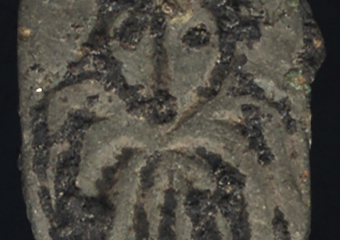Unique pendant proves the importance of Fortress Poros for the history of early Christianity on the southern Black Sea coast
For the third consecutive year, a team of Regional Burgas Museum headed by Milen Nikolov conducted archaeological research on the territory of Fortress Poros, which was funded by Municipality.[shrink]
Within one month between July and August, the survey was focused on the Roman villa with hypocaust from the 3rd century AD, discovered in 2013, over which in the 6th-7th century an early Byzantine complex was built.
First the archaeologists excavated the very large buildings from the 6th c., which exact parameters still can not be fully set. One of the buildings is 10 m wide, and the second - 8 m. Their walls are 1.1 m wide, constructed of well-formed stones with mud soldering. Under one of the buildings there are drainage channels of shaft for the wastewater. Among the findings is a pitos for the storage of agricultural production, but surprisingly typical everyday objects are missing on site. This suggests that the studied buildings are probably warehouses used for sending goods through the port of Poros. In support of this assumption comes the find of a depot with over 30 amphorae, which currently have been restored.
[photo = 1940 right 495x380]
After the study of early Byzantine strata the team reached the Roman villa walls. In this season, it became clear that it has dimensions of 20.8 m x 10 m and is composed of 9 rooms. Western of them have underfloor heating called hypocaust, and the floor is made of cast in place very strong pink mortar or tiles. The villa was built in the middle of the 3rd c. AD and existed until the 30s of the 4th century.
Nearly 200 artifacts have been discovered only during this season. Most belong to the Roman era: one half preserved exquisite statue of a man in toga, bronze applications, many silver and bronze coins from the end of the 2nd to the first half of the 4th c., luxurious redfigured ceramics, a huge amount of marble tiles and marble moldings for windows. The coins represent of all emperors from the 6th to the beginning of 7th c., among which stand out those of Anastasius, Justin I, Justinian the Great, Justin and Sofia, Tiberius Constantine, Maurice Tiberius, Foca. Found were also bone applications, awls and clay lamps, and handle of a very large earthen lamp with a cross.
This year once again the archaeological season at the castle Poros brought to light an extremely valuable find. A large bronze medallion with enamel was found in one of the buildings from the 6th c. It has a circular shape with a diameter of 35 mm. The central image represents cross with equal arms around which are depicted another 7 equal-armed crosses. Finds like this one are very rare in the archaeological world. Similar medallions were made of bronze, silver and gold ornaments to decorate church utensils. On the reverse side of the medallion from Foros can be seen traces of wood, which shows that it was mounted on a wooden base. The crosses depicted on the find relate it to the early Christianity. There is enough data showing that similar medallions decorated wooden boxes or covers of liturgical books. So at this stage we assume that the medallion from Foros fretted exactly cover of Gospel or box in which liturgical object was preserved - book, chalice and others.
[photo = 1941 right 495x380]
In form and decoration the medallion from Foros is extremely close to an image of the Church of San Vitale in Ravenna, Italy. The importance of the discovery is proven by the fact that in the long-researched cities of the Late Antique like Nessebar, Sozopol, Deultum, Ahtopol, Urdoviza and generally in the South Black Sea coast, such a finding has not been discovered until now, making the medallion from Foros unique to our region.
[widget="photo" name="a190" params="albid=190&rows=1&width=500"]


Comments
comments powered by Disqus